|
Special Features





Image Libraries


|
|
Blog
|
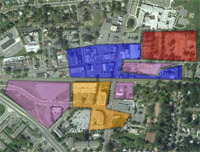
Downtown Gaithersburg. Blue is the historic heart, red is the 2008 redevelopment now under construction, orange is the 1990s redevelopment, and purple is potential redevelopment areas. |
Downtown Gaithersburg pretty much stinks. The old agricultural/industrial village was left behind during the 20th Century suburban and New Urbanist development booms that defined Gaithersburg as most people know it today. As a result, few people ever go there, and almost nobody considers it the heart of the larger Gaithersburg community.
But it has potential, and is slowly but surely making progress.
Downtown Gaithersburg has a nice core of historic urban structures surrounding a MARC commuter rail station that is just gorgeous. If it were filled in with more people and activity, it might look a lot like Clarendon. And it just so happens that there’s a ton of underused industrial land all around begging to be put to better use.
The first step came in the late 1990s, with a multi-building redevelopment that added offices, apartments, shops, and a concert pavilion. In 2003 the City of Gaithersburg followed up with an ambitious and beautiful master plan for downtown, identifying where and how redevelopment should take place. Following that, in 2008, the next major private sector redevelopment was approved. It would add about 400 apartments and street front retail right in the very heart of downtown.
And then the economy tanked, and nothing happened.
Until now.
According to DCmud, ground has been broken on the 2008 plan, which is now actively moving forward. While not exactly a skyscraper, the project will result in a radical transformation of East Diamond Avenue, the main commercial street in downtown. Rather than looking like a museum piece, downtown Gaithersburg’s main street will soon look like a genuine city street for the first time in decades. Really great news, indeed.

Under construction now on Diamond Avenue. Click to enlarge.
Where downtown Gaithersburg goes from here is an open question. It could sit for another 10 years without any more activity, falling further behind the other urban centers in Gaithersburg and Montgomery County. Or, if most of the redevelopment called for in the 2003 plan actually happens, downtown Gaithersburg could take its rightful place alongside the Bethesdas and Rockvilles of the world.
Wouldn’t that be something.
Average Rating: 4.9 out of 5 based on 185 user reviews.
December 30th, 2010 | Permalink
Tags: development, urbandesign

|
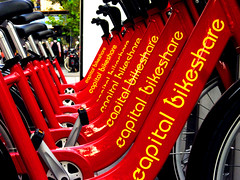
Capital Bikeshare |
When transportation historians write about bikesharing in the US, they will look back on 2010 as a watershed year. After years of pilot programs and other incremental steps, it was in 2010 that real large-scale bikesharing finally appeared in the US, first in Denver, and later in Minneapolis and Washington.
To commemorate the big year, here is a list of all existing US bikesharing systems, ranked by size (according to the excellent Bike-Sharing Blog).
The coming years promise to take bikesharing to even greater heights. Several of the existing systems will expand, and large new networks will soon launch in Miami, New York, Boston, and a host of other important cities.
Average Rating: 4.6 out of 5 based on 211 user reviews.
December 29th, 2010 | Permalink
Tags: bike, transportation

I’m back in town. Miss anything important? How did Gabe Klein’s community bike ride go? Did A&R Development ever release info on that 4th WalMart? Did DC do away with the height limit?
I’ll share my photos from Florida – including the Town of Celebration and the Disney monorail – when I get them off my camera. Now: Back to the grind.
Average Rating: 4.7 out of 5 based on 286 user reviews.
December 28th, 2010 | Permalink
Tags: site

The Corridor Cities Transitway, a proposed light rail or BRT line running north from Shady Grove Metro through Gaithersburg, has had its fair share of planning controversy.
In 2006 I berated planners for ignoring the many walkable, urban neighborhoods near the route and instead opting to locate stations near large parking lots. Around the same time, Montgomery County’s activist Action Committee For Transit proposed a U-shaped realignment that would have solved those problems, but would have required a fairly dramatic re-planning effort.
To their credit, MTA heard the criticism and responded. They are now strongly considering a series of three realignments that would dramatically improve access to walkable destinations and increase expected ridership on the line.

Three proposed realignments shown in green, red, and yellow.
The first two realignments, those shown in green and yellow, would more directly serve dense, walkable, mixed-use developments. The green one would move to run through the center and densest part of Crown Farm, a massive TOD-to-be. The yellow alignment would provide a station at Kentlands, the famous New Urbanist development.
The red alignment will more directly serve the so-called Science City. Although that won’t be a particularly walkable destination, it is dense with jobs and will provide a significant boost in expected ridership.
All together, these three changes are expected to increase ridership from somewhere between 21, 000-30, 000 daily (depending on mode and other factors) to between 29, 000-42, 000 daily, at a cost of about $100 million on top of the estimates for the original alignment. That’s such a phenomenally good deal that it would set the Corridor Cities Transitway as one of the most cost-effective projects in the pipeline in the entire country, therefore positioning it excellently to receive federal funds.
MTA should adopt all three realignments. Each one improves transit access to important destinations over the original route, and each improve Maryland’s chances of receiving federal funds.
Average Rating: 4.5 out of 5 based on 288 user reviews.
December 17th, 2010 | Permalink
Tags: BRT, transportation

I will be out of town for the holidays until the day after Christmas. Don’t expect much blogging in the mean time.
There has been a lot of interest in the fourth WalMart design, so I want to give readers an update. The development teams of the first three locations were all extremely friendly and cooperative. They did a great job taking the community’s concerns seriously and answering questions promptly. Unfortunately, the developers of the fourth site, A & R Companies, have refused to answer any questions about the site. Their policy is that they don’t give interviews, and don’t talk about developments that are in the pipeline. WalMart’s representative has been very friendly, but apparently has not reached an agreement to provide information on this fourth site.
I can tell you the fourth site will be at the Capitol Gateway development, on East Capitol Street just inside the District border, near Capitol Heights Metro. WalMart will be part of the commercial component of the development, which takes up multiple blocks and includes several new residential buildings. Here is a site plan, from an old DCmud post.
On top of that, there’s not to much say. Rumor is that none of the four WalMarts will have surface parking, but that alone doesn’t guarantee urbanity. We could be looking at a design as bad as this one in Salt Lake City, or one as good as the H Street proposal in DC. Unfortunately, we’ll just have to wait to find out.
Average Rating: 4.5 out of 5 based on 179 user reviews.
December 17th, 2010 | Permalink
Tags: development, site, urbandesign

Construction of the Silver line continues. Here’s a photo of what will become the Wiehle Avenue station, taken by Chuck Samuelson of the Dulles Corridor Metrorail Project:
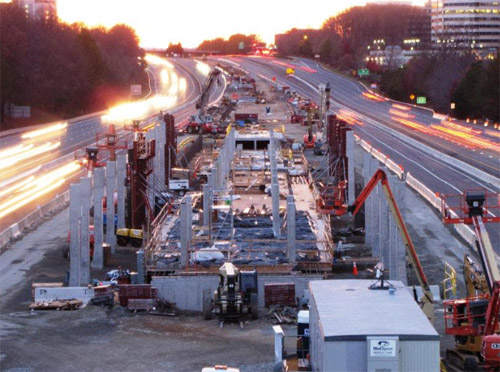
Average Rating: 4.8 out of 5 based on 171 user reviews.
December 15th, 2010 | Permalink
Tags: development, galleries, metrorail, transportation

|
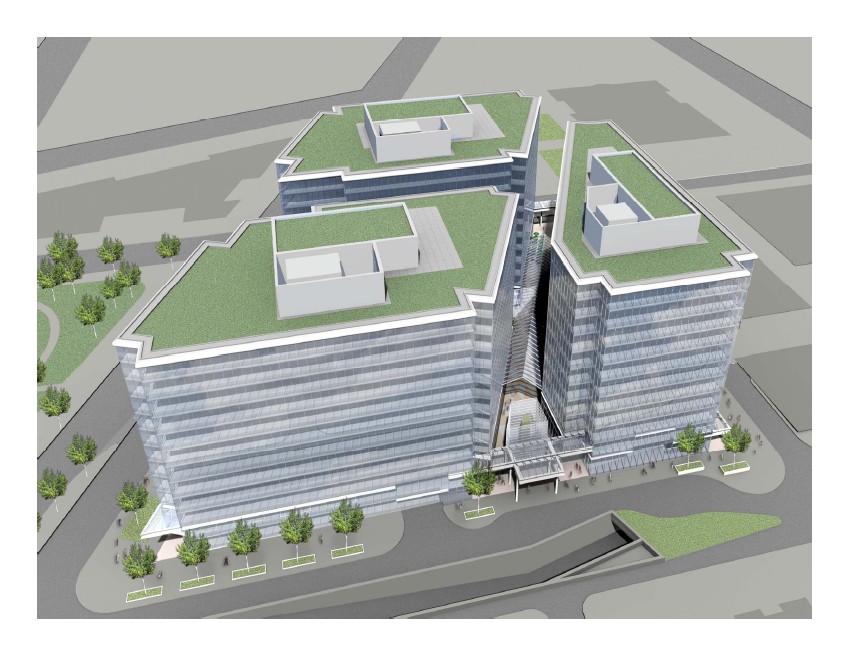
The new I-395 air rights proposal. Still boring. |
The I-395 air rights development in downtown Washington that I discussed last week has been redesigned. At that time I said it was good planning but bad architecture. That’s still true. The new design is marginally better with regards to urban design, but the architecture is as bland as ever.
What’s better: The old plan for this block called for two large buildings. The new plan calls for three slightly narrower ones. Narrow buildings are inherently more pedestrian friendly than wide ones, so this is an improvement. Compare the sidewalk vitality of a place like Georgetown to K Street. Both are lined with ground-floor retail, but in Georgetown there is a unique store with a unique facade every 25 feet, while on K Street the same storefront might take up half a block. More stuff on each block to look at and visit make Georgetown more pedestrian friendly.
The three buildings proposed here are more than the two from the previous proposal, therefore there’s more to look at, therefore this is better. But three buildings per block is not exactly a lot. The project would need thoughtful, vertically diverse architecture in order to be visually interesting. Unfortunately…
What’s not better: The architecture still stinks. We’re still looking at monolithic glass boxes that offer nothing in terms of visual interest, much less beauty. Even after the redesign, these buildings still look like the worst of boring architecture from 40 years ago.
Note to architects: Plain glass boxes aren’t good. Stop producing them.
Average Rating: 4.7 out of 5 based on 274 user reviews.
December 14th, 2010 | Permalink
Tags: architecture, development, urbandesign

Megabus is making Washington a major hub. Beginning on Wednesday, December 15, the popular low-cost intercity bus company will expand its destinations available from Washington from only New York to these ten new cities:

Map by BeyondDC.
More information is available at the Megabus website.
Update: Map updated to include Philadelphia, Baltimore, and Christiansburg, and to change the word “routes” to “destinations”.
Average Rating: 4.6 out of 5 based on 276 user reviews.
December 13th, 2010 | Permalink
Tags: intercity, transportation

Modern transit buses cost hundreds of thousands of dollars each. When a bus route shuts down it’s not economical to just scrap the vehicles. Instead, they’re usually sold or donated to other agencies.
Earlier this year the City of Falls Church discontinued its ‘George’ bus service, which ran between East and West Falls Church Metro stations. What happened to their buses? Take a look at this:
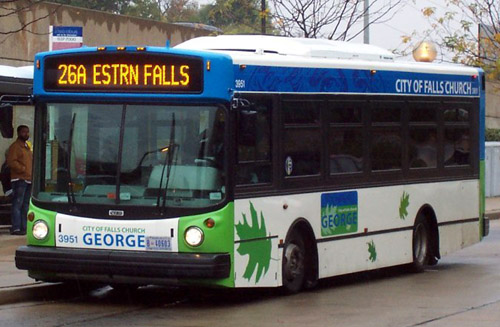 |
 |
| George bus. Image from Wikipedia. |
The same bus, now part of ART. Image from Eric N. Dobson. |
Notice anything familiar? That’s the same bus, repainted as part of the Arlington Transit fleet.
Average Rating: 4.4 out of 5 based on 271 user reviews.
December 9th, 2010 | Permalink
Tags: bus, galleries, transportation

|
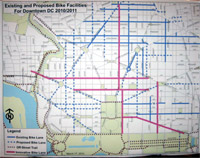
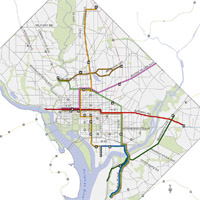
Are DDOT’s plans for extensive streetcar and cycle track networks safe? |
Today’s announcement that mayor-elect Vince Gray will let DDOT Director Gabe Klein go is extremely disappointing. If there’s one thing Gray could have done to show the city’s urbanists that he’s serious about sticking to the progressive policies that have defined DDOT in recent years, it would have been to keep Klein. Speaking personally, that would have won me over to Gray’s administration. Having sent Klein packing, doubt and suspicion are likely to continue.
But it’s happened, so now we’ll have to move on to the question of what Vince Gray’s DDOT will look like.
My hunch is that we’ll do a lot of treading water, and not much moving in either direction. I don’t think Gray will order DDOT to tear out the streetcar tracks on H Street or paint over the bike lanes that have gone in all over the city. That’s just not his style. But will DDOT’s long range plans be followed through with? That’s become a pressing question.
Gray seems committed to finishing the H Street and Anacostia streetcars, but what about the other 30-some miles of our planned 37 mile system? Will planning go on? And if planning does continue, will funding follow? Or will Gray do what Bob Ehrlich did to the Purple Line when he was governor of Maryland, and cut it without actually cutting it by leaving it stewing in planning limbo for most of his tenure? Likewise, will DDOT’s plans for a whole network of cycle tracks be followed through with, or will they be forgotten?
It’s almost unthinkable that the alternative transportation programs will be discontinued, but assuming they continue, at what level?
Average Rating: 4.9 out of 5 based on 260 user reviews.
December 8th, 2010 | Permalink
Tags: bike, government, streetcar, transportation

|
Media





Site
About BeyondDC
Archive 2003-06
Contact
Category Tags:
Partners
|
























